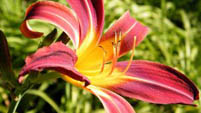
Purpose
To create a double color flower
Additional information
N/A
Sponsored Links
Required materials
- 1. White flower with stem and leaves
- 2. 2 Glass tumblers
- 3. Blade to slit the flower stem
- 4. Red dye (water soluble)
- 5. Water
Estimated Experiment Time
Approximately 10 minutes to set up the apparatus and 5-12 hours to carry out the observations
Step-By-Step Procedure
- 1. Fill two glasses with water.
- 2. Mix red dye in one of the tumblers.
- 3. Split the stem of the white flower.
- 4. Place one half of the stem in one glass and the other in the glass containing the dyed liquid.
- 5. Leave the set-up undisturbed for a few hours.
Note
After a few hours one half of the flower changes its original color.
Observation
The liquid rises through sap tubes (narrow columns) that produce the required capillary force. Capillary action carries water from the beakers to the petals of the white flower causing it to change color. It is the same phenomenon that causes water to move up plants and trees, through the roots, trunk or stem, and then into the flowers and leaves.
Result
Sponsored Links
Take a moment to visit our table of Periodic Elements page where you can get an in-depth view of all the elements,
complete with the industry first side-by-side element comparisons!